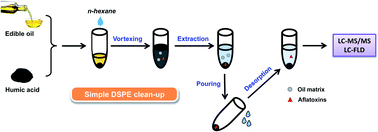Facile dispersive solid-phase extraction based on humic acid for the determination of aflatoxins in various edible oils†
Abstract
Aflatoxins (AFs), as the secondary metabolites of the toxigenic fungi Aspergillus flavus and Aspergillus parasiticus, are well known to be extremely harmful to humans and animals because of their high toxicity, mutagenicity, carcinogenicity, and teratogenicity. Recurring and increasing studies on AF ingestion incidents indicate that AF contamination is a serious food safety issue worldwide. Currently, immunoaffinity chromatography (IAC) has become the most conventional sample clean-up method for determining AFs in foodstuffs. However, the IAC method may be limited to some laboratories because it requires the use of expensive disposable cartridges and the IA procedure is time-consuming. Herein, to achieve the cost-effective determination of AFs in edible oils, we developed a dispersive solid-phase extraction (DSPE) clean-up method based on humic acids (HAs), which is followed by liquid chromatography coupled with tandem mass spectrometry (LC-MS/MS) analysis. HAs could be directly used as a DSPE sorbent after simple treatment without any chemical modification. In the HA-DSPE, AFs could remain on the HA sorbent by both hydrophobic and hydrophilic interactions, whereas the oil matrix was retained on HA via only hydrophobic interactions. The oil matrix could be sufficiently washed off by n-hexane, whereas the AFs could still be retained on HA; thus, the selective extraction of AFs and clean-up of oil matrices were achieved. Under the optimal conditions of HA-DSPE, satisfactory recoveries ranging from 81.3% to 106.2% for four AFs (B1, B2, G1, and G2) were achieved in various oil matrices i.e. blended oil, mixed olive oil, tea oil, sunflower seed oil, rapeseed oil, sesame oil, soybean oil, rice oil, corn oil, and peanut oil. Minor matrix effects ranging from 89.3% to 112.9% were obtained for the four AFs, which were acceptable. Moreover, the LODs of AFs between 0.063 and 0.102 μg kg−1 completely meet the regulatory levels fixed by the Food and Drug Administration (FDA), the European Union (EU), China, or other countries. The proposed methodology was further validated using a naturally contaminated peanut oil, and the results indicated that the accuracy of the HA-DSPE could match the accuracy of the referenced IAC. In addition, HA-DSPE can be used to directly treat diluted edible oil without liquid–liquid extraction and HA is cheap and can be easily obtained from the market worldwide; these advantages make the proposed methodology simple, low-cost, and accessible for the determination of AFs in edible oils.



 Please wait while we load your content...
Please wait while we load your content...